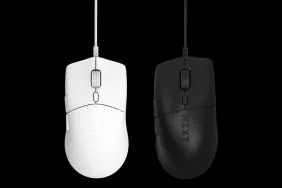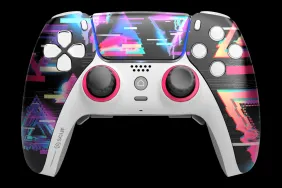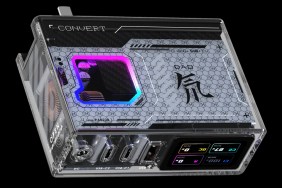The Beginning of the End
The End really is coming. Just in these last two weeks, we’ve seen not one but two immersive horror games appear for the tiny screens of handheld video game systems. One is Silent Hill: Origins. The other is Gamecock’s gutsy, ambitious Dementium: The Ward. With signs like this, I for one am ready to usher it in with sacrifices, altars, and dark idols.
[image1]The folks at Gamecock (whose July “funeral” for the ‘Death of E3’ – pardon my semi-inebriated camera-work – went, at joyous drunken length, like this) have done the nigh-unthinkable and published a full-on, survival horror first-person shooter for the DS. The box-quote claim of “Doom 3 meets Silent Hill” might sound a little grandiose, but flaws aside, the assessment is still more right than wrong.
Dementium doesn’t waste any time getting started. After a very brief point-of-view cinematic of your character being wheeled into a nasty-looking hospital – it looks like something out of Jacob’s Ladder – you’re unceremoniously dumped into a ward room with no introduction, no inventory items and no clue of where, when, or who you are. Rain pours and lighting flashes outside the windows of your miserable, darkened room, as you’re promptly walked through the basics of gameplay by some onscreen hints. The first objects you find are a key (to unlock the locked door) and a notepad, whose only entry is a page with the words “WHY DID YOU DO IT?” staring at you in an accusing scrawl.
That notepad, which you can always access, is pretty nifty, actually. At any time, you can use the stylus to jot notes for solutions to puzzles or whatever you like. It would have been cooler if you could make notations on the tiny maps sprawled about the hospital maps – but alas, no.
Once you’ve escaped from your room, you’re on your own. Clearly, something horrible has happened in the darkened corridors of this hospital, as evidenced by the strewn furniture and gore streaked on every other wall and hallway floor. The driving force behind the mystery is just exactly who you are and why you’re here. Your initial inventory choices are a flashlight and nightstick, but once you start finding guns you’ll realize this is, in fact, a fully-functioning first-person shooter. The 60-fps framerate is as fluid as you could want, and the stylus-based ‘mouse-look’ functions perfectly—not too twitchy or too sluggish.
[image2]You’ll need that responsive targeting, too – especially when you’ve got open-chest-wound shamblers groaning and tottering toward you on their zombie legs, or icky-crawly slug-things slithering out of the dark in waves and wailing like infants when you blast them. This is a true, look-everywhere shooter, so be sure to check your ten, twelve, and two. Some of those crawly-things can sneak up on you on the floors and high along the walls. When you use the nimble ‘stylus-look’ scheme successfully to track and kill incoming things quickly – bang, bang, bang – the responsive targeting really makes you feel like a gun-slinging badass (albeit with the, um, thin little stylus in your hand).
Of course, it’s not all combat: There are fetch-pass and code-locked doors, and some oh-so-slightly loftier puzzles (one in particular tests your knowledge of musical notes). But for the most part, the emphasis is on the first-person combat – and the eerie mood. This is a strange thing to praise on a two-something-inch screen, but the Renegade Kid developers have crammed in a surprising amount of detail in the atmosphere here. The Apart from the decent flashlight effect, there are some creepy sound effects – wailing children, chattering bug-things, rumbling rainstorms, minimal music. The fluidity of the onscreen motion – not to mention the numbers of enemies that can appear without bogging things down – is exceptional.
[image3]Another minor, nice touch is in the area of small ambient details, some of which may well escape the player’s notice: the way in which defeated shamblers disintegrate from the edges of their body-cavities inward to their open chest wounds leaving only empty, shrieking space; the patient-file clipboards found outside certain ward-rooms, logged with the names of various Gamecock (and presumably, Renegade Kid) employees, as well as their suggested treatments.
The downsides are much more fundamental, which is a pity, because they drag down what is otherwise an ambitious title. The save system kicks you back to the beginning of each chapter when you die, which means having to work through an entire floor again. And if you clear out a hallway filled with monsters – often using up precious ammo – proceed through a door and then re-enter the area you just cleared, you will find ALL the monsters respawned. Well, shit.
This wouldn’t be so bad if the precious ammo and all-important healing medicine also respawned, but of course they aren’t. The upshot of this is that the time-tested Silent Hill method of “escape from the monsters through the nearest door, but if it’s even shittier on that side, immediately come back” doesn’t work. The short version is: Make damned sure of your path the first time, so you don’t have to backtrack.
Problem is that’s difficult, too. While it’s very cool to be able to jot notes in your own chicken-scratch on the lower-screen notepad, you can’t make notations on the actual maps, for blocked doorways, collapsed floors, or what have you. Another gripe is that, for whatever reason, your onscreen persona can only hold either a flashlight or a weapon – not both.
[image4]You’ll need to juggle Johnny-on-the-spot between the flashlight to see the enemies sooner and the gun to neutralize them. It does, arguably, make things a little more tense, although probably not the way the designers intended. At least the aiming cursor turns red over viable targets, especially enemies at a distance and in the dark, even if you can’t see what you’re shooting at. Indeed, one left-handed point of ‘good news’ here is that, in this creepy, fudged-up hospice, you don’t need to worry about friendly fire.
There’s some repetition in the layouts for the rooms and floors, and frankly, there’s not much incentive for replay, but it’s a solid, challenging and surprisingly atmospheric, creepy ride while it lasts. It’s a hopeful sign of good (by which I mean, with any luck, very, very bad) things to come for the horror experience on handheld game systems.
-
True FPS horror...on the tiny DS screen!
-
Eerie visuals/audio presentation
-
Smooth, responsive action
-
Clever details
-
Annoying save scheme
-
Repetitive respawns
-
God, my wrist!











